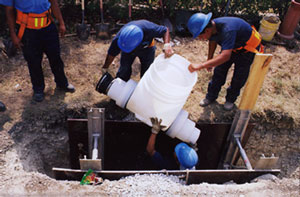Wastewater Access Chambers Provide Cost-Effective Alternative to Conventional Manholes
The WAC product, developed by Molded Access Products (formerly AquaBlok), a division of Uponor ETI, is designed to replace conventional concrete pre-cast and poured-in-place manholes, at a 40% to 50% cost reduction. In addition to manholes, the product also can replace cleanouts and effluent sampling ports through the use of a leak-proof and corrosion-resistant structure.
The collection system may be accessed by way of the WAC, thus preventing human entry into the chamber, which can be hazardous and undesirable to municipal employees. The advent of a "manless" access point has been well received by those who must maintain the municipal collection systems.

History of Man in Sewer Systems
Ever since sanitary sewer systems have been in existence, man has designed a method to gain access into the piping system for maintenance and inspection.
In the early years, most sewer systems were combined sanitary and storm systems because the cost of treating municipal sewerage was not a major financial strain. As time progressed and cities grew, municipalities required more sophisticated sanitary sewer collection and treatment facilities, thus increasing the amount of capacity required to treat all the fluids that reached the treatment plants.
In the past, many municipalities did not concern themselves with determining what percentage of the liquid that reached the treatment plant really needed treatment. In contrast, most cities today are well aware of their infiltration/inflow (I&I) statistics relative to the actual demands on their treatment facilities, based on the population in their communities.
Reducing Infiltration & Inflow
Due to the increased treatment costs and EPA pressures to reduce I&I, many cities have implemented aggressive programs to reduce excess flow into their treatment plants.
During the process of evaluating the cause of I&I, it has been determined that the manholes in the system are a major contributor to the problem. Some consultants have attributed as much as 60% of a system's I&I to manhole leakage problems.
Historically, manholes have been constructed of brick and block, which offer many areas of water intrusion from the invert to the manhole casting. Until recently, cities had to live with the problem and deal with the excess flow by constructing larger treatment plants.
The WAC is rotationally molded of polyethylene to a thickness of 3/8 in., providing a structure strong enough to withstand burial depths in the 25- to 30-ft range. The WAC is easily adaptable to standard SDR 35 sewer pipe, sizes 6-12 in., and may cut installation time in half.
The end product provides access into the collection system (12 in. and under) for all of the currently available maintenance equipment and televising systems; all of the capabilities with no human entry. The typical installation costs for the unit are 50% to 75% less than conventional manholes.
This article was submitted by Don Yonts of Uponor ETI and edited by Tracy Fabre.
